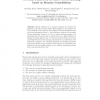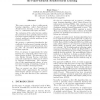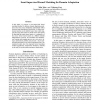174 search results - page 9 / 35 » The Moving Target Function Problem in Multi-Agent Learning |
ICANNGA
2007
Springer
13 years 9 months ago
2007
Springer
Neural networks are a popular technique for learning the adaptive control of non-linear plants. When applied to the complex control of android robots, however, they suffer from se...
IWANN
1999
Springer
13 years 12 months ago
1999
Springer
To avoid the curse of dimensionality, function approximators are used in reinforcement learning to learn value functions for individual states. In order to make better use of comp...
ICML
1996
IEEE
13 years 11 months ago
1996
IEEE
This paper presents a direct reinforcement learning algorithm, called Finite-Element Reinforcement Learning, in the continuous case, i.e. continuous state-space and time. The eval...
AAAI
2012
11 years 10 months ago
2012
In this paper, we propose a semi-supervised kernel matching method to address domain adaptation problems where the source distribution substantially differs from the target distri...
BMCBI
2006
13 years 7 months ago
2006
Background: Many different aspects of cellular signalling, trafficking and targeting mechanisms are mediated by interactions between proteins and peptides. Representative examples...



